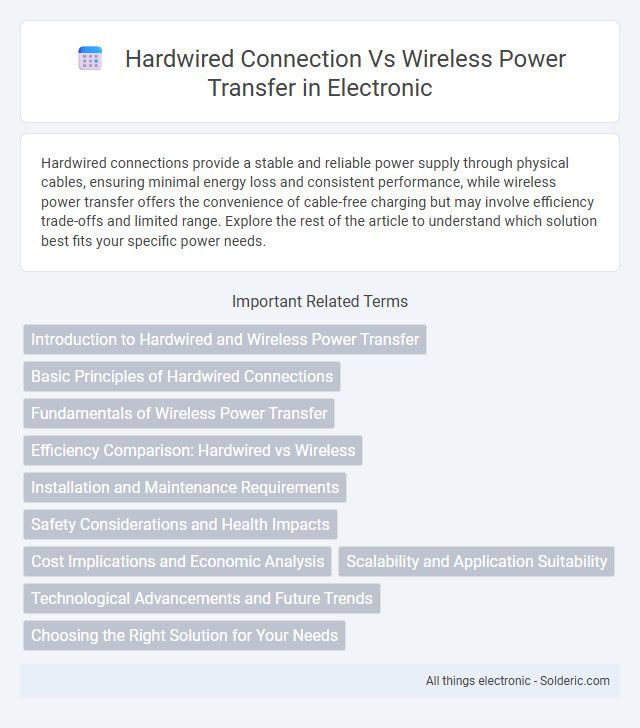Hardwired connections provide a stable and reliable power supply through physical cables, ensuring minimal energy loss and consistent performance, while wireless power transfer offers the convenience of cable-free charging but may involve efficiency trade-offs and limited range. Explore the rest of the article to understand which solution best fits your specific power needs.
Comparison Table
| Feature | Hardwired Connection | Wireless Power Transfer |
|---|---|---|
| Power Delivery | Direct, stable, high efficiency | Indirect, moderate efficiency, subject to alignment |
| Mobility | Limited, tethered | High, cable-free operation |
| Installation Complexity | Requires cables and connectors | Minimal physical connection, requires transmitter and receiver |
| Safety | Risk of electrical shock from exposed wiring | Safe, low electromagnetic exposure when standardized |
| Maintenance | Periodic cable inspection and replacement | Less mechanical wear, potential electronic component issues |
| Range | Limited to cable length | Short to medium distance, varies by technology |
| Cost | Lower upfront cost | Higher cost due to specialized hardware |
| Applications | Traditional electronics, charging stations, industrial uses | Mobile devices, electric vehicles, medical implants |
Introduction to Hardwired and Wireless Power Transfer
Hardwired power transfer relies on physical cables to deliver electrical energy directly from a power source to a device, ensuring stable and efficient energy transmission with minimal loss. Wireless power transfer uses electromagnetic fields, such as inductive coupling or resonant inductive coupling, to transmit energy without physical connectors, increasing convenience and enabling mobility. Key applications of hardwired connections include traditional electrical grids and charging stations, while wireless power transfer finds use in consumer electronics, electric vehicle charging, and medical implants.
Basic Principles of Hardwired Connections
Hardwired connections rely on physical cables or conductors to transmit electrical signals or power between devices, ensuring stable and low-latency communication with minimal interference. This method uses copper wires, fiber optics, or coaxial cables to provide reliable data transfer and consistent energy delivery. The direct physical link reduces signal loss and electromagnetic interference, making hardwired connections ideal for applications requiring high-speed and secure communication.
Fundamentals of Wireless Power Transfer
Wireless power transfer (WPT) relies on electromagnetic fields to transmit energy between a transmitter and receiver without physical connectors, primarily using techniques like inductive coupling, resonant inductive coupling, and capacitive coupling. Inductive coupling operates over short distances by generating a magnetic field through coils, while resonant inductive coupling extends range and efficiency by tuning both coils to resonate at the same frequency. Capacitive coupling transfers energy via electric fields between conductive plates, though it is less common due to limitations in power and distance.
Efficiency Comparison: Hardwired vs Wireless
Hardwired connections deliver near 90-95% power transfer efficiency by minimizing energy loss through direct physical conduits, making them ideal for high-demand applications. Wireless power transfer efficiency typically ranges between 60-85%, influenced by factors like distance, alignment, and interference, which can cause notable energy dissipation. Your choice between hardwired and wireless solutions should consider these efficiency differences, especially for critical or energy-sensitive devices.
Installation and Maintenance Requirements
Hardwired connections require physical cables for installation, demanding more labor and structural modifications, such as drilling and cable management, which can increase time and cost. Maintenance involves regular inspection for wear, corrosion, and potential damage to connectors or cables, ensuring consistent performance and safety. Wireless power transfer systems eliminate physical connectors, reducing installation complexity and allowing easier maintenance by minimizing mechanical wear and environmental exposure.
Safety Considerations and Health Impacts
Hardwired connections offer stable power delivery with minimal electromagnetic interference, reducing potential health risks associated with prolonged exposure to electromagnetic fields (EMFs). Wireless power transfer systems emit low-level RF radiation, which some studies suggest may cause thermal effects or biological changes with long-term exposure, necessitating rigorous safety standards and regulatory oversight. Ensuring proper shielding, power limits, and continuous monitoring remains essential to mitigate health impacts in wireless power applications.
Cost Implications and Economic Analysis
Hardwired connections generally involve higher upfront installation costs due to materials and labor but offer lower long-term operational expenses with stable energy transfer efficiency. Wireless power transfer systems, while reducing installation complexity and offering flexible device connectivity, often carry higher initial investment and maintenance costs linked to energy loss and technology upgrades. Your choice between these options should consider total cost of ownership, including energy efficiency, scalability, and lifecycle expenses.
Scalability and Application Suitability
Hardwired connections offer superior scalability for high-power applications and data-intensive environments, making them ideal for industrial automation and data centers. Wireless power transfer suits low-power devices and IoT applications where mobility and ease of installation are prioritized, though it faces limitations in range and efficiency at scale. Choosing between them depends on balancing power demands, scalability needs, and the specific operational context of the application.
Technological Advancements and Future Trends
Hardwired connection technology has evolved with faster transmission speeds and enhanced reliability through fiber optics and USB-C interfaces, offering stable power delivery for critical devices. Wireless power transfer is advancing via resonant inductive coupling and RF energy harvesting, enabling efficient and flexible charging for wearables, electric vehicles, and IoT devices. Your choice between these depends on future trends emphasizing mobility, energy efficiency, and integration with smart infrastructure.
Choosing the Right Solution for Your Needs
Selecting between hardwired connections and wireless power transfer depends on factors such as efficiency, convenience, and application environment. Hardwired connections offer higher power efficiency and reliability for stationary devices, while wireless power transfer provides flexibility and ease of use for portable and frequently moved equipment. Evaluating device compatibility, power requirements, and installation constraints ensures optimal performance and user experience.
Hardwired connection vs Wireless power transfer Infographic

 solderic.com
solderic.com